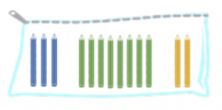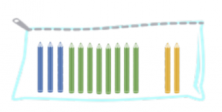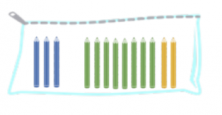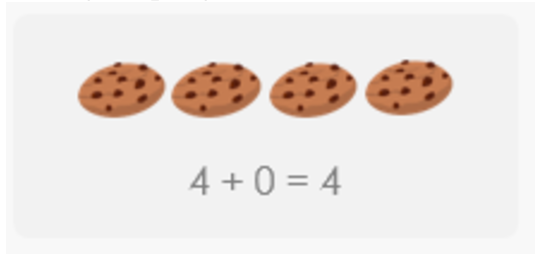We will learn about the addition properties through an everyday situation: Preparing a backpack for school.

Shall we begin?
We look for an empty backpack and open it. First, we put in 3 large notebooks and then 6 small notebooks. How many notebooks are there in the bag?
 To answer this question, simply add the number of large notebooks plus the number of small notebooks.
To answer this question, simply add the number of large notebooks plus the number of small notebooks.
3 + 6 = 9
There are 9 notebooks in the backpack.
Would there still be nine notebooks in the backpack if we placed the small notebooks in the backpack before the big ones? Let’s look:

6 + 3 = 9
Yes, there would still be 9 notebooks.
The result of the addition will be the same regardless of the order of the addends (which in this case are 3 and 6).
This is the first of the addition properties and it is known as the Commutative Property

The order of the addends (numbers being added) does not affect the results.
It is a very useful property when you have to add two numbers and one of them is greater than the other. If you have to add 3 + 34, it will be easier if you reverse it and start with 34 and add 3. Try it out! The next time you have to do a sum, begin with the larger number.
Now we continue with the preparation of the backpack…
We find an empty case and place 3 green pencils, 8 yellow pencils and 2 blue pencils inside. How many pencils are in the case?

To know how many there are, we add:
3 + 8 + 2 =
How is this addition done?
By first adding eight and three, then adding two to the result?
(3 + 8) + 2 =
 Or first adding eight and two, then adding three to the result?
Or first adding eight and two, then adding three to the result?
3 + (8 + 2)

It can be done either way and the result will be the same.
When we have three or more addends, you can start adding the first two and add the third to the result, or the reverse, start adding the second and the third and add the first to the result.
This is the second of the addition properties and is known as the Associative Property

The method of grouping the addends does not affect the sum.
The associative property can also help with addition. Take advantage of the associative property and make groups that suit you! In this case, the second option is easier, starting by adding eight and two because we know it is equal to ten.
To finish preparing the backpack, we are just missing a snack!
We put 4 chocolate cookies and 0 oatmeal cookies in the backpack. We have no oatmeal cookies! How many cookies are there altogether in the backpack?
There are 4 cookies in the backpack.
The sum of any number plus zero (0) is equal to the same number. So zero (0) is the identity for addition.
Any number plus zero is equal to the same number.
This is the third of the addition properties and is known as the Identity Property

And there you have it! Addition has three properties.
And as always, if you want to learn more elementary math, sign up for free at Smartick!
Learn More:
- Review the Different Properties of Multiplication
- Properties of Multiplication
- Learn the Different Properties of Multiplication
- The Distributive Property of Multiplication
- What is the Associative Property of Multiplication?







